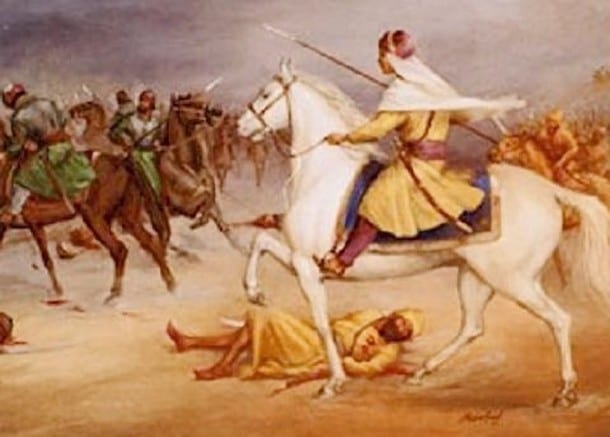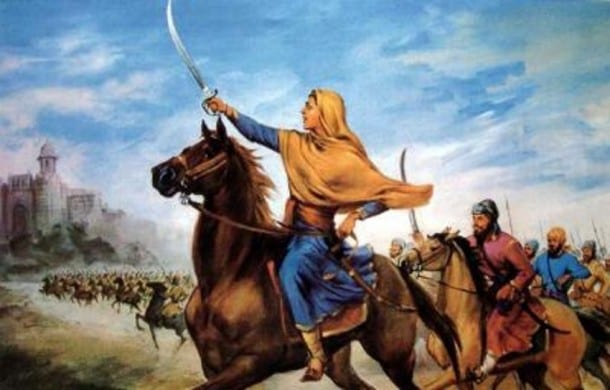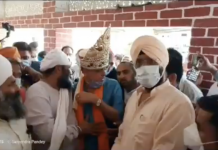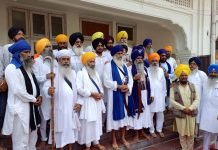There was no shortage of women who played prominent roles during in Sikh history – be it during the times of the Sikh Gurus, the period during which Sikhs defeated the Mughals, the Anglo-Sikh wars, resistance against the British, India’s independence, and the struggle for justice during the later part of the 20th century. However, their roles have often been neglected or not given the same prominence. It is the need of our times to ensure women are given a deserving place in Sikh history.
To honor Women History Month in March, Sikh24 will be publishing a series of articles exploring the role of women in Sikh history and prominent Kaurs from the present-day Sikh struggles.
If you are interested in submitting an article on this topic, please do not hesitate to get in touch.
In this post, let’s explore the role of two prominent Sikh women, one who played a key role during the Misls period and another during the rule of Ahmad Shah Abdali.
Bibi Shamsher Kaur
After being abducted and then rescued by Sikhs but refused by her own father, the Sikhs make Bibi Shamsher Kaur a daughter of the Khalsa. She took Khande Di Pahul and became a warrior saint when she rescued other captured women and led a force of 1,000 strong.
An aged Brahmin (Priest) came crying to Sardar Jassa Singh Ramgarhia of Hansi, now in the state of Haryana. The priest told him that Ali Beg, the chief of Hissar while hunting, came to his village and forcibly took his two daughters. He said that he begged and cried a lot, but none of the villagers came to his rescue. The chief also turned a deaf ear to his request and said, “How can I leave such beautiful and young girls? Get me two other beautiful young girls, and take yours.”
The priest, who was weeping bitterly, said, “I am losing my eyesight. I would commit suicide if I could not get my daughters back. You are the shelter of the shelterless. Kindly take pity on me.”
The Sardar consoled him and promised that his daughters would be returned to him if they were alive.
At nightfall, the Sardar took a party of Sikh soldiers, rode towards Hissar, and surrounded the fort at Hissar within three hours. At that time, Ali Beg was drinking while some slave girls were dancing. The Sikh soldiers broke the door of the fort and challenged Ali Beg. In the ensuing battle, three Sikh soldiers died. Meanwhile, Ali Beg was injured, and many of his soldiers were killed. Ali Beg appealed for mercy and handed over those two girls and three others he also abducted. The Sardar took pity on Ali Beg’s queens and conceded to their request not to kill Ali Beg. He returned to Hansi before dawn. He did not loot the fort but warned Ali Beg to behave in the future.
The Sardar called the priest and said, “Take your daughters to your village and marry them to suitable matches. I can help you financially if you desire.”
The priest thanked the Sardar for saving his daughters from a devil but expressed his fear that if he took his daughters to his village, none of his relatives would have any dealings with him as the girls have lived in the company of Muslims and taken their food. The Sardar encouraged the Brahmin and said, ” Take the girls with you. I also shall try to find some suitable match for the girls and arrange their marriages.” The Brahmin unwillingly agreed and left for his village.
After a week, the priest came back weeping to the Sardar. On being asked, he said, “None in the village is willing to talk to me. They want me to leave the girls with Ali Beg, or he might attack the village and abduct the girls again whenever he finds a chance.”
The elder daughter, Shamo, said to Jassa Singh, “Sardar Ji, I will never go back to the village and live among cowards. Our father has been crying since he left you. Kindly let us live here.”
The Sardar said to the priest, “I shall treat these girls as my daughters and get them married when I find suitable matches. They can live among the families of my soldiers and take food from the common kitchen. You may go to your village.”
The new environment and society changed the life of young girls. They adopted the dress of Sikh girls as well as their eating habits. They served in the common kitchen, prayed with others, and started to learn to use arms. Shamo was more intelligent than Ramo. She was quick to learn reading Punjabi, horse riding, and the use of weaponry. Upon their request, both the sisters were baptized. The elder one was named Shamsher Kaur, and the younger one, Ram Kaur. The Sardar proposed two soldiers as the girls’ husbands, and with the consent of all concerned, they were married.
It was the period of feudalism, and big landlords like Ali Beg ruled over certain territories under their control. Might was right. Sikh Sardars like Jassa Singh in Punjab were also divided into eleven groups called Misls. Every group was headed by a Sardar and controlled a certain area. Sardar Jassa Singh was the head of Ramgarhia Misl and ruled over the area surrounding Batala in Punjab. He was defeated by the Sardars of Kanhiya, Shukarchakia, and Ahluwalia Misls, in 1778 and had to flee far away from his territory to Hansi. He conquered a large area near Hansi, where he saved the two daughters of the priest.
In 1785, differences arose between the chiefs of Kanhiya and Shukarchakia Misls. Sardar Mahan Singh of Shukarchakia Misl invited Sardar Jassa Singh Ramgarhia to Punjab and promised to help him get back his lost territory if he, in turn, would help him to defeat the chief of the Kanhiya Misl. Jassa Singh Ramgarhia grasped this golden opportunity to get back the lost territories and his honor. Shamsher Kaur and her husband insisted on accompanying him to help him fight against his enemies. Jassa Singh wanted them to stay back and supervise his area, but he yielded when Shamsher Kaur insisted on going with him. In the fierce battle at Batala, Shamsher Kaur fought like a brave and loyal soldier, and it resulted in the victory of Jassa Singh Ramgarhia. He was so pleased with the active part taken by Shamsher Kaur that he bestowed upon her five villages near Hansi and asked her to go back with a few soldiers to look after the area so that tyrants wouldn’t bother the innocent.
She thanked the Sardar for his blessings, and together with her husband, started for Hansi. She dressed like a male soldier and was known only as Shamsher. Many did not know that Shamsher was a female. She was a kind and popular ruler of her small kingdom and preached Sikhism. She set right many dacoits and other bad characters. She never tolerated female oppression and was very popular among the people of the area. The poor thought that God had sent her to save them from the tyrants.



Mohammad Ali, chief of the village Kot Ali Khan in that area, was a lustful young man who secretly planned to marry Razia, his servant Haider’s young daughter, forcibly. Razia and her parents did not like the idea, as Mohamed Ali already had many wives. Razia and her mother left the village at midnight to save themselves from the chief. When the chief came to know of it, he took Haider to the task and told him that he was getting a bad name because his daughter and wife had left the village. He ordered him to present them as he wanted to marry Razia. Haider said, “Sir, you already have many wives. We cannot spoil the life of our daughter by marrying her with you, and besides, my daughter does not like the proposal.”
∂The chief did not listen and ordered his men to arrest Haider and put him in prison. The chief sent his soldiers to find Razia and bring her and her mother to him. The soldiers found the ladies and brought them back to the chief.
Razia was thirsty and requested the soldiers to let her take a watermelon from the field nearby. They agreed and allowed her to take a watermelon. In the meantime, 20 Sikh horsemen with their leader appeared on the scene and asked the soldiers about the ladies. The soldiers told a lie, but Razia told them the real story. The leader, Shamsher Kaur, ordered the soldier to leave the ladies, go back, and tell their chief to release Razia’s father, or the chief and his entire family would be killed. The soldiers surrendered their arms and went back to their chief. Shamsher Kaur took Razia on her own horse, gave her mother a separate horse, and with her soldiers left for Hansi. She took both the ladies to her house. When she changed her clothes, the ladies were surprised to find that their savior was a lady.
Mohammad Ali would not release Razia’s father. One night when he was busy drinking and watching a beautiful girl dance, his watchmen cried that enemies had surrounded them. At once, Shamsher and her soldiers climbed the tree near Mohamad Ali’s house’s walls and raised slogans of “Long live Shamsher.”
Mohammad Ali and his soldiers were taken aback when the Sikh soldiers with their leader jumped into the house from the tree. Those who resisted them were killed. Mohammad Ali drew his sword, but soon his sword was broken, and he surrendered. He handed over the keys of the prison. Shamsher rescued Razia’s father and brought him to her headquarters. She set Mohammad Ali free when he requested forgiveness and promised not to repeat such actions in the future.
Ali could not tolerate this insult. He held a meeting of the Muslim chiefs of the area and said, “It is a matter of shame that a Sikh lady should rule over us. She has a lot of money in her fort. If you help me, we can catch her. You may take the money and leave her for me.” They agreed and brought their forces to help him. Altogether they had about 3,000 mercenaries.
Shamsher and her husband left the fort and faced them in the open so that they might not be surrounded in the fort. There was a lot of bloodshed, and many from both sides were killed. Ali challenged Shamsher to come forward and fight one to one. She raised the slogan of “Bole So Nihal, Sat Sri Akal” and, with a stroke of her sword, cut Ali’s right arm. With the second stroke, she separated his head from his body. Her husband was badly injured in the battle. Now the remaining Muslim soldiers took to their heels. Her husband did not recover despite the available treatment and breathed his last. She treated it as the will of God and did not cry.
Now she was left alone, but she did not lose heart. The next year, Marathas from west India conquered Agra, and after subduing many petty chiefs, they sent a message to Shamsher to hand over her territory to them and leave her fort. They had an army of many thousands, but she had only one thousand soldiers. Neither Jassa Singh Ramgarhia nor any other Sikh chief could help her as they were far away. She decided that she preferred death to subordination. She and her soldiers fought bravely against the enemy. Many soldiers from both sides died fighting. It is said that her dead body had as many as thirty injuries. Her name is still mentioned in folklore, and older adults of the area remember her with respect.



Bibi Baghel Kaur
Before she became Baghel Kaur, she was a newlywed Hindu bride who Ahmad Shah Abdali’s soldiers abducted on the way back to her in-law’s home. The groom approached various heads of the state, but no one cared to help him. He then turned to the Sikhs who lived in the jungles. During this time, Sikhs would attack Abdali’s carriages and free many Hindu women he captured when he invaded India.
Sikhs offered the groom help and rescued his wife successfully. The bride wanted to commit suicide as she was in terrible condition, but the Sikhs encouraged her to live. She then took Khande Di Pahul and became Baghel Kaur. Her husband also took Amrit and became Teja Singh.
Baghel Kaur became skilled with the sword. She vowed to take revenge and was successful in attacking a patrolling party of the Mughal Soldiers. She was a Sikh warrior under Nawab Kapur Singh, who took the Mughals head-on challenge in hand-to-hand combat. Nawab Kapur divided the Khalsa Fauj into groups. A few hundred Kaurs joined them along with Bibi Baghel Kaur. About 50 Mughal soldiers came to attack Bibi Baghel Kaur and her party. She came forward and cut at the Mughal soldier’s sword-fighting valiantly. Bibi Ji’s group then joined the other Sikh groups. The Sikh warriors told her to stay behind in the jungle, but she refused and wanted to become shaheed while fighting for the Khalsa Fauj. She then led her group and successfully attacked a camp in Lahore where many women had been captured. Along with her group, she saved many of the women in that camp and killed 25 soldiers. She attempted to rescue more women, but while courageously battling, she was killed by a soldier. The next day about 8,000 Sikhs attacked the same camp where she had become shaheed and rescued many of the women still captured there.
Bibi Baghel Kaur is an inspiration to all women of the world. After becoming Sikh, she never lost faith in her Sikhi but fought until her last breath and rescued many captured women.





[…] Brave and Inspirational Sikh Women in History – Bibi Shamsher Kaur and Bibi Baghel Kaur […]
Now days you can hardly find a Sikh woman likes of which are mentioned above.